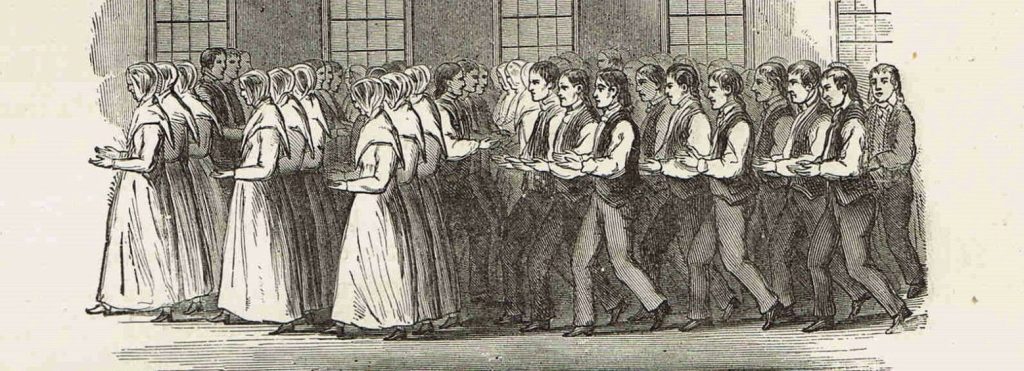
Shaker Dances and Marches
by Sister Lillian Phelps, Canterbury, New Hampshire.
Many persons are curious as to the reason for using dancing or marching, in our earlier religious services. It is amazing how much sound reason is behind the thinking of the early Shaker leaders, and how much psychology was employed.
It was the belief of the Shakers that every faculty should be used in the worship of God, and so, various forms of physical exercise were introduced, particularly the March. A group of eight or ten singers, occupied the center of the room, around which the members marched in perfect formation. It was with a graceful, rhythmic motion of the hands as the members marched to the slow or quick tempo of the music.
Dancing, or the March, was not such a strange occurrence during a religious service of the early days of the Church. We have mention, in the Old Testament, of David and Miriam dancing before the Lord. Also there are 19 instances where dancing is mentioned in the Mosaic Law.
There was also a definite psychological purpose behind the Shaker marches, seldom explained, and rarely understood by the general Public. The perfect rhythmic body motions, of a worshipper, who combined this activity with a deep mental and religious fervor, developed within himself, a great spiritual inspiration, almost impossible to understand or describe, by one who has never witnessed or participated in this form of worship. But if one could have been present, as I was, and could have seen the perfect spiritual union that was produced when a soul combined the physical motions, the singing voice and the dedicated heart, in giving praise and thanks to God—I’m sure you would have agreed that the physical motions added a still greater dimension to the expression of Prayer. However, as years passed, and older members were unable to join in these marches, the exercises were discontinued, as it was considered necessary to maintain a perfect union among the members, a service in which all may participate as One.
Today, our Church Service is quiet and more formal, resembling, perhaps the Prayer meetings held in many of the churches of other denominations.
This material is taken from Industries and Inventions of the Shakers: SHAKER MUSIC, A Brief History by Sister Bertha Lindsay and Sister Lillian Phelps (Canterbury, NH, United Society of Believers, 1961). A digital version of this booklet is available online.

